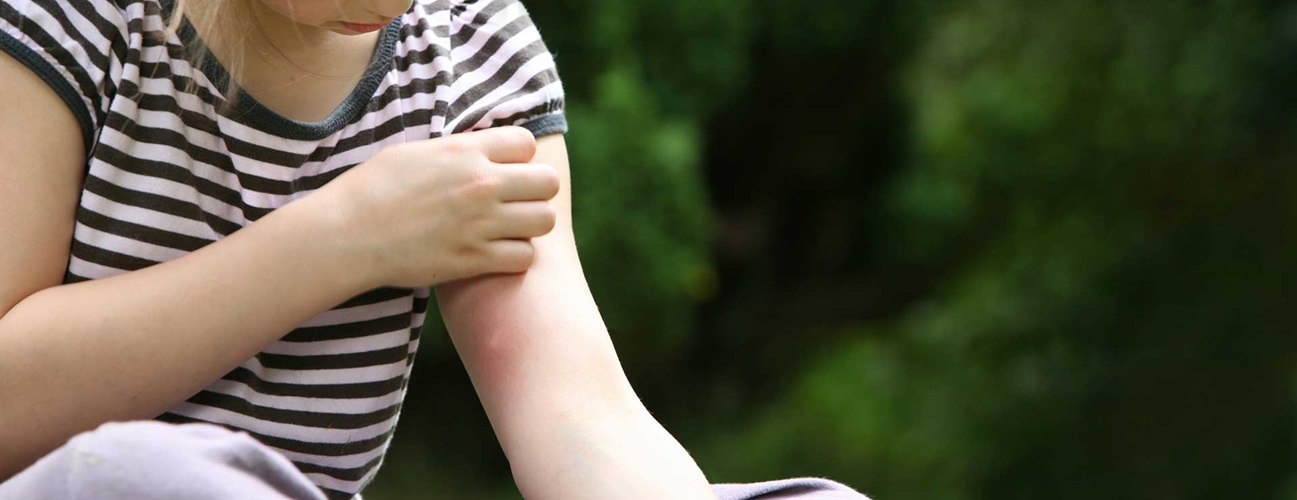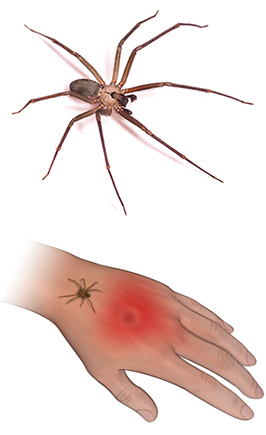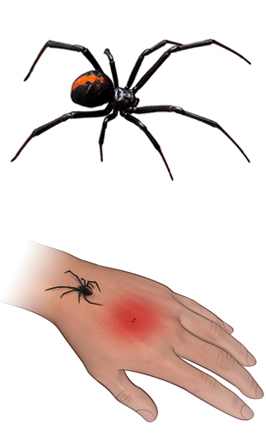Spider Bites
Which spider bites are dangerous?
Most spiders found in the United States are harmless, with the exception of the black widow and the brown recluse spiders. Both of these spiders are found in warm climates.
What is a brown recluse spider?
The brown recluse spider, or violin spider, is about 1-inch long and has a violin-shaped mark on its upper back. It is often found in warm, dry climates and prefers to stay in undisturbed areas such as basements, closets, and attics. It is not an aggressive spider, but will attack if trapped or held against the skin. No deaths have been reported in the U.S. from a brown recluse bite.
What are the symptoms of a brown recluse spider bite?
Venom from the brown recluse spider usually causes local tissue damage. The following are the most common symptoms of a bite from a brown recluse spider:
-
Burning, pain, itching, or redness at the site which is usually delayed and may develop within several hours or days of the bite
-
A deep blue or purple area around the bite, surrounded by a whitish ring and large red outer ring similar to a "bulls eye"
-
An ulcer or blister that turns black
-
Headache, body aches
-
Rash
-
Fever
-
Nausea or vomiting
The symptoms of a brown recluse spider bite may look like other conditions or medical problems. Always see your healthcare provider for a diagnosis.
What is the treatment for a brown recluse spider bite?
Specific treatment for a brown recluse spider bite will be determined by your healthcare provider. Treatment may include the following:
-
Wash the area well with soap and water.
-
Apply a cold or ice pack wrapped in a cloth, or a cold, wet washcloth to the site.
-
Protect against infection, particularly in children, by applying an antibiotic lotion or cream.
-
Give medicine for pain.
-
Elevate the site if the bite happened on an arm or leg to help prevent swelling.
-
Seek immediate emergency care for further treatment. Depending on the severity of the bite, surgical treatment of the ulcerated area may be needed. Hospitalization may be needed.
Prompt treatment is essential to avoid more serious complications, especially in children.
What is a black widow spider?
A black widow spider is a small, shiny, black, button-shaped spider with a red hourglass mark on its belly, and prefers warm climates. Black widow spider bites release a toxin that can cause damage to the nervous system, so emergency medical treatment is needed.
What are the symptoms of a black widow spider bite?
The following are the most common symptoms of a black widow spider bite:
-
Immediate pain, burning, swelling, and redness at the site (double fang marks may be seen)
-
Cramping pain and muscle rigidity in the stomach, chest, shoulders, and back
-
Headache
-
Dizziness
-
Rash and itching
-
Restlessness and anxiety
-
Sweating
-
Eyelid swelling
-
Nausea or vomiting
-
Salivation, tearing of the eyes
-
Weakness, tremors, or paralysis, especially in the legs
These symptoms of a black widow spider bite may look like other conditions or medical problems. Always see your healthcare provider for a diagnosis.
What is the treatment for a black widow spider bite?
Your healthcare provider will determine specific treatment for a black widow spider bite. Treatment may include the following:
-
Wash the area well with soap and water.
-
Apply a cold or ice pack wrapped in a cloth, or a cold, wet washcloth to the site.
-
Protect against infection, particularly in children, by applying an antibiotic lotion or cream.
-
Give medicine for pain.
-
Elevate the site if the bite happened on an arm or leg (to help prevent swelling).
-
Seek emergency care right away for further treatment. Depending on the severity of the bite, treatment may include muscle relaxants, pain relievers and other medicines, and supportive care. Antivenin may be needed, although it is usually not required. Hospitalization may be needed.
Prompt treatment is essential to avoid more serious complications, especially in children.








